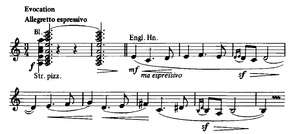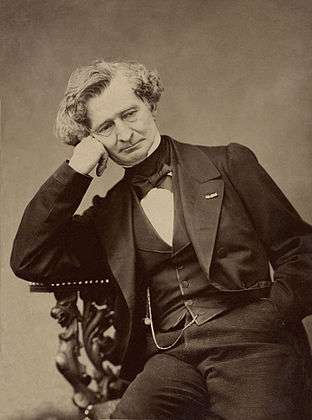Harold en Italie
Harold en Italie, Symphonie en quatre parties avec un alto principal (English: Harold in Italy, Symphony in Four Parts with Viola Obbligato), Op. 16, is Hector Berlioz's second symphony, written in 1834.
Creation
Niccolò Paganini (1782–1840) encouraged Berlioz (1803–1869) to write Harold en Italie. The two first met after a concert of Berlioz’s works conducted by Narcisse Girard on 22 December 1833, three years after the premiere of Berlioz’s Symphonie fantastique. Paganini had acquired a superb viola, a Stradivarius—"But I have no suitable music. Would you like to write a solo for viola? You are the only one I can trust for this task."
Berlioz began "by writing a solo for viola, but one which involved the orchestra in such a way as not to reduce the effectiveness of the orchestral contribution." When Paganini saw the sketch of the allegro movement, with all the rests in the viola part, he told Berlioz it would not do, and that he expected to be playing continuously.[1] They then parted, with Paganini disappointed.
Description






Harold en Italie is a four-movement work featuring an extensive part for solo viola.
Lord Byron's poem Childe Harold's Pilgrimage inspired the mood of Harold. Berlioz wrote, "My intention was to write a series of orchestral scenes, in which the solo viola would be involved as a more or less active participant while retaining its own character. By placing it among the poetic memories formed from my wanderings in the Abruzzi, I wanted to make the viola a kind of melancholy dreamer in the manner of Byron’s Childe-Harold." That he had recycled some of the material from his discarded concert overture, Rob Roy, went unmentioned. Despite Berlioz' mention of Byron, music critics, such as Donald Tovey have taken pains to point out that "Harold in Italy" owes nearly nothing to the poem: "no definite elements of Byron's poem have penetrated the impregnable fortress of Berlioz's encyclopaedic inattention,...there is no trace in Berlioz's music of any of the famous passages of Childe Harold."[2]
The first movement ("Harold aux montagnes") refers to the scenes that Harold, the melancholic character, encounters in mountains. In the second movement ("Marche des pèlerins"), Harold accompanies a group of pilgrims.
The third movement ("Sérénade") involves a love scene; someone plays a serenade for his mistress. In the fourth movement, ("Orgie de brigands"), spiritually tired and depressed, Harold seeks comfort among wild and dangerous company, perhaps in a tavern. Jacques Barzun reminds us that "The brigand of Berlioz’s time is the avenger of social injustice, the rebel against the City, who resorts to nature for healing the wounds of social man."[3]
Throughout the symphony, the viola represents Harold's character. The manner in which the viola theme hesitantly repeats its opening phrase—gaining confidence, like an idea forming, before the long melody spills out in its entirety—was satirized in a musical paper after the premiere. It began "Ha! ha! ha! – haro! haro! Harold!"—a cheeky touch that Berlioz recalled years later in his Memoirs.
In addition to the solo viola, the work calls for 2 flutes (2nd doubling piccolo), 2 oboes (1st doubling cor anglais in Movement III), 2 clarinets in C (Movements I, III, and IV) and A (Movement II), 4 bassoons, 4 horns, 2 cornets, 2 trumpets, 3 trombones, tuba, timpani, cymbals, triangle, 2 tambourines, harp and strings.
History
Harold in Italy was premiered on 23 November 1834 with the Orchestre de la Société des Concerts du Conservatoire, Chrétien Urhan playing the viola part, Narcisse Girard conducting. Even though the second movement "March of the Pilgrims" received an encore, this performance contributed to Berlioz's decision to conduct his own music in the future.
Paganini did not hear the work he had commissioned until 16 December 1838; then he was so overwhelmed by it that, following the performance, he dragged Berlioz onto the stage and there knelt and kissed his hand before a wildly cheering audience and applauding musicians. A few days later he sent Berlioz a letter of congratulations, enclosing a bank draft for 20,000 francs.
Franz Liszt prepared a piano transcription (with viola accompaniment) of the work in 1836 (S.472).
- Notable performances
- 1842, 1 February, Paris, Salle Vivienne – Jean-Delphin Alard (soloist); Berlioz (conductor)
- 1842, 26 September, Brussels – Heinrich Wilhelm Ernst (soloist); Berlioz (conductor)
- 1847, 5 May, Saint Petersburg premiere – Heinrich Wilhelm Ernst (soloist); Berlioz (conductor)
- 1848, 7 February, London premiere – Henry Hill (1808–1846) (soloist); Berlioz (conductor); Drury Lane Theatre[4]
- 1853, 22 November, Bremen – Joseph Joachim (soloist); Berlioz (conductor)
- 1853, 1 December, Leipzig – Ferdinand David (soloist); Berlioz (conductor); Gewandhaus Orchestra
- 1868, 11 January, Moscow – Ferdinand Laub (soloist); Berlioz (conductor); Moscow Conservatory Orchestra
- 1868, 8 February, Saint Petersburg – Hieronymus Weickmann (soloist); Berlioz (conductor); final performance under the direction of the composer
- 1937, 4 February – Lionel Tertis (soloist, his last public performance); Ernest Ansermet; BBC Symphony Orchestra[5]
The first studio recording was made by RCA in 1944 with William Primrose and the Boston Symphony Orchestra conducted by Serge Koussevitzky.
The piece was used in Terrence Malick's 2013 film To The Wonder, starring Ben Affleck and Olga Kurylenko. The film has several visual references to the composition's content and history.
Recordings
- William Primrose, NBC Symphony Orchestra, Arturo Toscanini, January 2, 1939 Live Broadcast[8]
- William Primrose, Boston Symphony Orchestra, Serge Koussevitzky, 1944
- Gunther Breitenbach, Vienna Symphony, Rudolf Moralt, 1950
- William Primrose, Royal Philharmonic Orchestra, Thomas Beecham, 1952
- Carlton Cooley, NBC Symphony Orchestra, Arturo Toscanini, 1953
- Frederick Riddle, London Philharmonic Orchestra, Hermann Scherchen, 1953
- Joseph de Pasquale, Boston Symphony Orchestra, Charles Munch, 1954
- Ladisla Cerny, Czech Philharmonic Orchestra, Vaclav Jiracek, 1955
- Frederick Riddle, Royal Philharmonic Orchestra, Sir Thomas Beecham, 1956
- Heinz Kirchner, Berliner Philharmoniker, Igor Markevitch, 1957
- William Primrose, Boston Symphony Orchestra, Charles Munch, 1958
- William Lincer, New York Philharmonic, Leonard Bernstein, 1961
- Yehudi Menuhin, Philharmonia Orchestra, Colin Davis, 1963
- Klass Boon, Royal Concertgebouw Orchestra, Pierre Monteux, 1963
- Georg Schmid, Bavarian Radio Symphony Orchestra, Rafael Kubelik, 1964
- Rudolf Barshai, Moscow Philharmonic Orchestra, David Oistrakh, 1964
- Walter Trampler, London Symphony Orchestra, Georges Prêtre, 1969
- Joseph de Pasquale, Philadelphia Orchestra, Eugene Ormandy, 1970
- Claude Ducrocq, Orchestre philharmonique de Strasbourg, Alain Lombard, 1974
- Nobuko Imai, London Symphony Orchestra, Colin Davis, 1975
- Daniel Benyamini, Israel Philharmonic Orchestra, Zubin Mehta, 1975
- Joseph Suk, Czech Philharmonic Orchestra, Dietrich Fischer-Dieskau, 1976
- Donald McInnes, Orchestre National de France, Leonard Bernstein, 1977
- Pinchas Zukerman, Orchestre de Paris, Daniel Barenboim, 1977
- Robert Vernon, Cleveland Orchestra, Lorin Maazel, 1977
- Yuri Bashmet, USSR State Radio and Television Symphony Orchestra, Vladimir Fedoseyev, 1981
- Lubomir Jaly, Czech Philharmonic Orchestra, František Jílek, 1981
- Milan Telecky, Slovak Radio Symphony Orchestra, Onderj Lenard, 1982
- Wolfram Christ, Berlin Philharmonic Orchestra, Lorin Maazel, 1985
- Douglas McNabney, Orchestre Symphonique de Quebec, Simon Streatfield, 1985
- Pinchas Zukerman, Montreal Symphony Orchestra, Charles Dutoit, 1988
- Yuri Bashmet, Frankfurt Radio Symphony Orchestra, Eliahu Inbal, 1989
- Gérard Caussé, Orchestre du Capitole de Toulouse, Michel Plasson, 1991
- Gerard Caussé, Orchestre Révolutionnaire et Romantique, John Eliot Gardiner, 1994
- Laurent Verney, Orchestre de l’Opéra Bastille, Myung-whun Chung, 1996
- Bruno Pasquier, Orchestre Philharmonique Regional Montpellier, Cyril Diederich, 1996
- Bruno Giuranna, BBC Symphony Orchestra, Maxim Shostakovich, 1996
- Rivka Golani, San Diego Symphony, Yoav Talmi, 1996
- Gérard Caussé, Orchestra del Teatro La Fenice, Jean Fournet, 1997
- Mikhail Tolpygo, USSR State Academic Symphony Orchestra, David Oistrakh, 1997
- Csaba Erdélyi, New Zealand Symphony Orchestra, Marc Taddei, 2001
- Tabea Zimmermann, London Symphony Orchestra, Colin Davis, 2003
- Naoko Shimizu, Sendai Philharmonic Orchestra, Kazuhiro Koizumi, 2007
- Jean-Eric Soucy, Southwest German Radio Symphony Orchestra, Sylvain Camberling, 2009
- Antoine Tamestit, Les Musiciens du Louvre, Marc Minkowski, 2011
- Stefano Passaggio, Zagreb Philharmonic Orchestra, Milan Horvat, 2011
- David Aaron Carpenter, Helsinki Philharmonic Orchestra, Vladimir Ashkenazy, 2011
Notes
- ↑ Berlioz Harold in Italy
- ↑ Tovey, Donald (1981). Symphonies and Other Orchestral Works: Selections from Essays in Musical Analysis. London: Oxford University Press. p. 171. ISBN 0486784525.
- ↑ In Berlioz and His Century, noted by Freed.
- ↑ Riley, Maurice W. (1980), "19th Century Violists: Hermann Ritter", The History of the Viola, Volume I, Ann Arbor, Michigan: Braun-Brumfield, p. 208
- ↑ Riley, Maurice W. (1980), "19th Century Violists: Hermann Ritter", The History of the Viola, Volume I, Ann Arbor, Michigan: Braun-Brumfield, p. 246
- ↑ http://www.hberlioz.com/music/symphonies.htm
- ↑ http://www.musicweb-international.com/Ntl_discogs/French_symphonies/French_Symphonies.htm#berlioz
- ↑ Remastered and released as Music and Arts Programs of America: CD-4614, 2003.
Bibliography
- Berlioz, Hector. Memoirs. ch. 45
- Berlioz website: Harold in Italy
- Stolba, K. Marie. The Development of Western Music: A History. The McGraw-Hill Companies, Inc.; New York, New York; 1998.
- Richard Freed, program notes, 2005
- D. Kern Holoman, program notes, 1996
Further reading
- Sir Donald Tovey, essay on Harold in Italy in Essays in Musical Analysis, vol. IV
External links
- Harold in Italy: Scores at the International Music Score Library Project
- BBC Discovering Music (page down for link to .ram file discussing the work)
- Viola-in-Music.com | Harold in Italy
